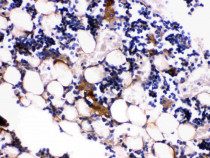ARG59340
anti-Osteocalcin antibody
anti-Osteocalcin antibody for IHC-Formalin-fixed paraffin-embedded sections and Mouse
Overview
| Product Description | Rabbit Polyclonal antibody recognizes Osteocalcin |
|---|---|
| Tested Reactivity | Ms |
| Tested Application | IHC-P |
| Host | Rabbit |
| Clonality | Polyclonal |
| Isotype | IgG |
| Target Name | Osteocalcin |
| Antigen Species | Mouse |
| Immunogen | Recombinant protein corresponding to Y50-I95 of Mouse Osteocalcin. |
| Conjugation | Un-conjugated |
| Alternate Names | OCN; Gamma-carboxyglutamic acid-containing protein; Osteocalcin; OC; Bone Gla protein; BGP |
Application Instructions
| Application Suggestion |
|
||||
|---|---|---|---|---|---|
| Application Note | IHC-P: Antigen Retrieval: Heat mediated was performed in Citrate buffer (pH 6.0) for 20 min. * The dilutions indicate recommended starting dilutions and the optimal dilutions or concentrations should be determined by the scientist. |
Properties
| Form | Liquid |
|---|---|
| Purification | Affinity purification with immunogen. |
| Buffer | 0.9% NaCl, 0.2% Na2HPO4, 0.05% Sodium azide and 5% BSA. |
| Preservative | 0.05% Sodium azide |
| Stabilizer | 5% BSA |
| Concentration | 0.5 mg/ml |
| Storage Instruction | For continuous use, store undiluted antibody at 2-8°C for up to a week. For long-term storage, aliquot and store at -20°C or below. Storage in frost free freezers is not recommended. Avoid repeated freeze/thaw cycles. Suggest spin the vial prior to opening. The antibody solution should be gently mixed before use. |
| Note | For laboratory research only, not for drug, diagnostic or other use. |
Bioinformation
| Database Links | |
|---|---|
| Gene Symbol | BGLAP |
| Gene Full Name | bone gamma-carboxyglutamate (gla) protein |
| Background | This gene encodes a highly abundant bone protein secreted by osteoblasts that regulates bone remodeling and energy metabolism. The encoded protein contains a Gla (gamma carboxyglutamate) domain, which functions in binding to calcium and hydroxyapatite, the mineral component of bone. Serum osteocalcin levels may be negatively correlated with metabolic syndrome. Read-through transcription exists between this gene and the neighboring upstream gene, PMF1 (polyamine-modulated factor 1), but the encoded protein only shows sequence identity with the upstream gene product. [provided by RefSeq, Jun 2015] |
| Function | Constitutes 1-2% of the total bone protein. It binds strongly to apatite and calcium. [UniProt] |
| Cellular Localization | Secreted. [UniProt] |
| Calculated MW | 11 kDa |
| PTM | Gamma-carboxyglutamate residues are formed by vitamin K dependent carboxylation. These residues are essential for the binding of calcium. [UniProt] |
Images (1) Click the Picture to Zoom In
-
ARG59340 anti-Osteocalcin antibody IHC-P image
Immunohistochemistry: Paraffin-embedded Mouse tibia tissue. Antigen Retrieval: Heat mediated was performed in Citrate buffer (pH 6.0, epitope retrieval solution) for 20 min. The tissue section was blocked with 10% goat serum. The tissue section was then stained with ARG59340 anti-Osteocalcin antibody at 1 µg/ml, overnight at 4°C.






